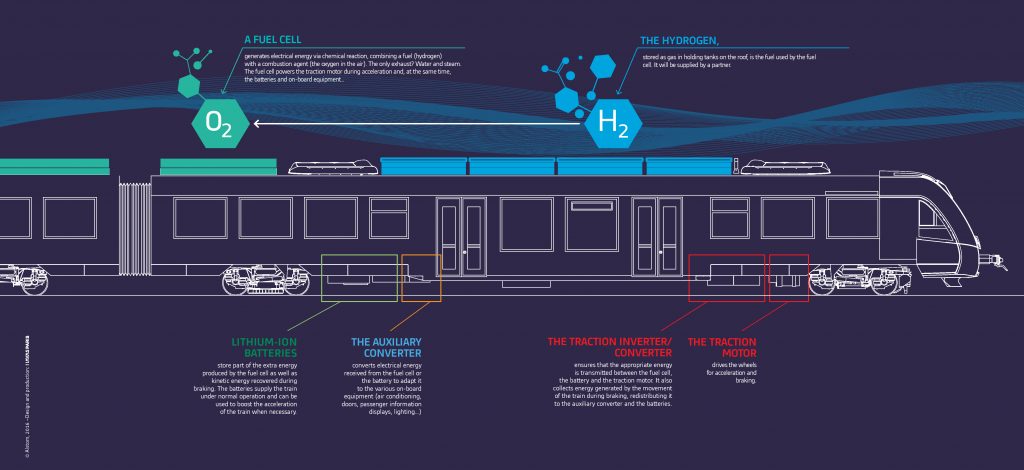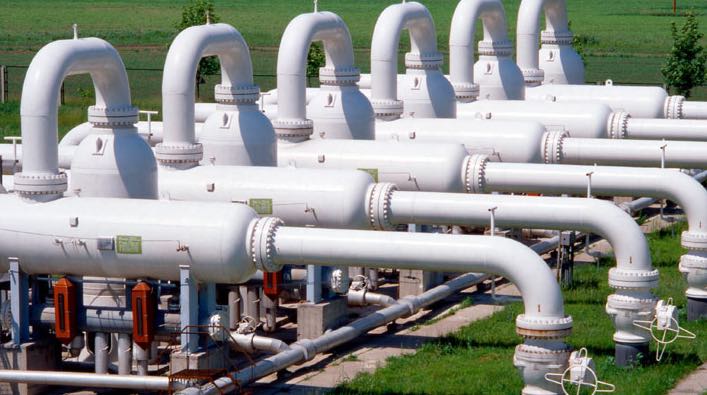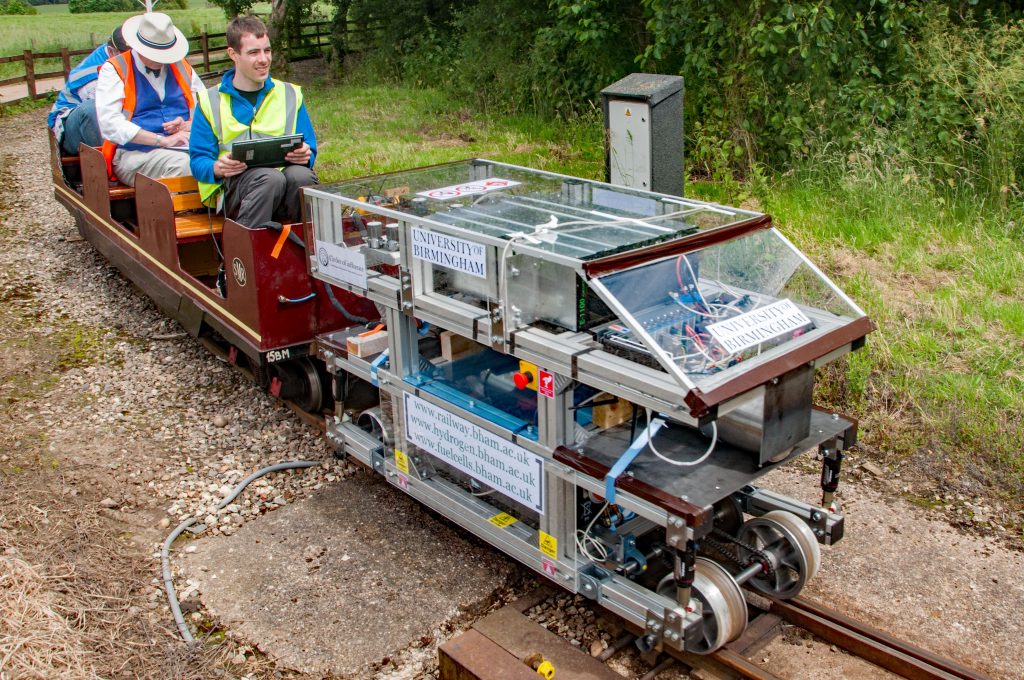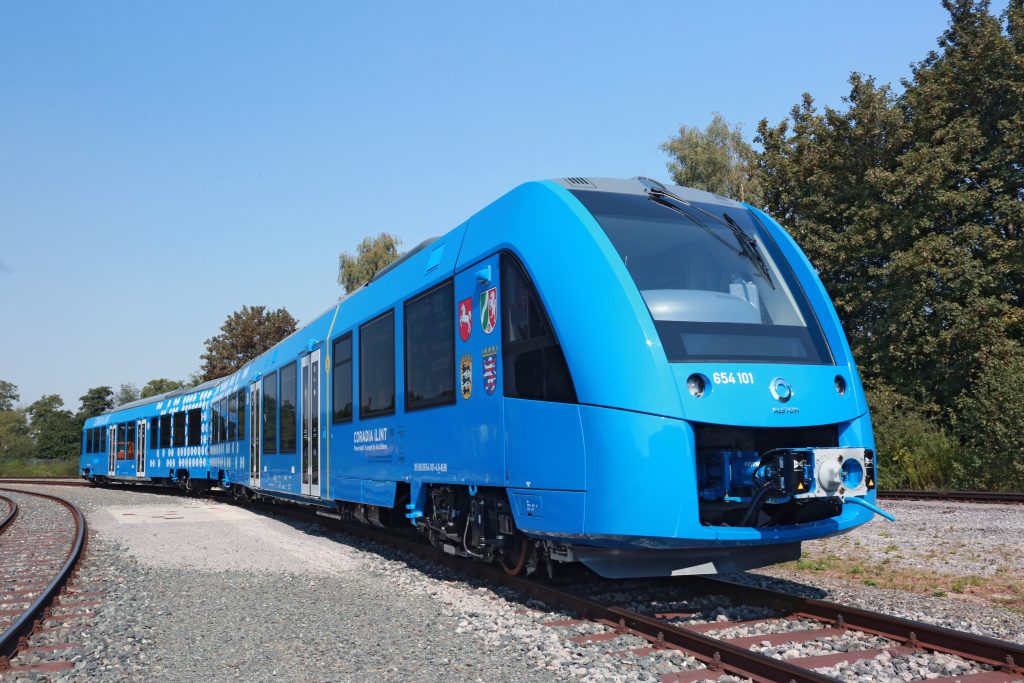Hydrogen may be what replaces diesel engines in the future.
I’m not sure it will work on cars but for bigger movers like trains and ships it very well may.
(Long article, sorry)
Hydrail comes of age
Hydrail, the term coined for hydrogen-powered trains, started to become well known when the first annual international hydrail conference was held in North Carolina in 2005. While the first conference was largely an academic affair, by the time the 2017 hydrail conference was held in Graz, Austria, most of the speakers were from hydrail related businesses, a sure sign that the technology has come of age.
Visitors to InnoTrans in 2016 were provided with definitive evidence that hydrail is now a viable technology as Alstom launched its hydrogen powered Coradia iLint train. With the creation of the Hydrogen Council in January 2017, hydrogen is becoming big business as the Council’s founding members, 13 transport and energy companies (including Alstom), plan to invest 10 billion euros in hydrogen technologies over the next five years.
Alstom’s iLint is the latest and most promising of a number of hydrail vehicles produced since the first Hydrail conference. In 2006, the East Japan Railway Company unveiled the world’s first fuel-cell hybrid railcar powered by two 95kW fuel cells. Other pioneering light-rail hydrail vehicles were a tram powered by two 12kW fuel cells unveiled by Spanish metre-gauge operator FEVE in 2011 for use in Asturias, and 200kW hydrogen-powered trams which started operation in Qingdao, China, in 2015.
The first hydrogen powered locomotive ran in 2010. This was a 130-ton diesel shunter which was developed by the US Army Corps of Engineers, BNSF rail freight company and Vehicle Projects Inc which used a 240kW fuel cell provided by Ballard. Vehicle Projects and Ballard also collaborated in the production of five 17kW hydrail mine locomotives for the Republic of South Africa in 2012. A year later, China’s South West Jaitong University successfully ran a 45-tonne fuel-cell locomotive with a 150-kW fuel cell.
In the UK, the University of Birmingham produced Britain’s first hydrogen powered locomotive. This was a 10¼ inch gauge locomotive with a 1.1kW fuel cell supplemented with batteries to give a total power output of 4.4kW. This competed in the Institution of Mechanical Engineer’s Railway Challenge in 2012. Later that year, the University had its locomotive on show when it hosted the seventh Hydrail conference.
The UK’s first hydrogen-powered locomotive at the 2012 Railway Challenge – what next?
An energy vector
The chemical substance that is water has two hydrogen molecules for every oxygen molecule. Hydrogen is thus available in abundance, yet it is too chemically active to occur naturally. Its main use is for oil refining and the production of ammonia.
Most hydrogen is produced from fossil fuels by steam reforming. ‘Green’ hydrogen is produced by electrolysis of water, which splits it into hydrogen and oxygen. This does not consume fossil fuels or produce CO2 but is around twice the cost of steam reforming, although this can be reduced using off-peak wind-generated electricity.
In a hydrogen fuel cell, the process is reversed as the reaction between hydrogen and a catalyst on an anode produces positively charged hydrogen ions, which are then allowed by an electrolyte to pass to a cathode. Electricity, water and heat are produced as a result.
The increasing use of wind power to generate electricity produces large amounts of surplus power overnight. This changes the economics of electrolysis and offers an entirely carbon-free way of producing hydrogen on demand. Hydrogen is thus an energy vector, a medium for conveniently transporting, storing and converting energy into electricity and vice versa.
For this reason, hydrogen powered trains have been described as electric trains as their fuel is produced by electricity. The difference between them and conventional electric trains is that, instead of the catenary, there is a hydrogen production and distribution network. The efficiency of converting electricity to hydrogen and back for rail traction is just under thirty per cent, which is about the same as a diesel engine but much less than conventional electric traction.
Using hydrogen produced from natural gas to power rail vehicles instead of diesel reduces CO2 emissions by about forty per cent and gives broadly similar fuel costs. Green hydrogen is currently almost twice the cost of diesel but offers zero emissions, enabling a single iLint unit to save 700 tonnes of CO2 emissions per year.
A wind farm in Lower Saxony.
Landesnahverkehrsgesellschaft Niedersachsen (LNVG)
LNVG is the public transport service for Lower Saxony, Germany’s second largest state, most of which is made up of the North German Plain that is bordered by the North Sea and, to the west, the Netherlands. It is therefore not surprising that it is Germany’s leading wind-power state. With an installed wind power capacity of over 9,000MW, it produces twenty per cent of Germany’s wind-generated electricity and has plans to increase this to 20,000MW by 2050.
Lower Saxony is thus an ideal place to introduce hydrogen-powered trains and so was one of four German states (the others being North-Rhine Westphalia, Hesse and Baden Württemberg) that signed letters of intent with Alstom for a total of 50 hydrail units in 2014, leading to the production of the Coradia iLint.
On 9 November, contracts for the delivery of 14 hydrogen-powered iLints, complete with 30 years of maintenance and fuelling, were signed by LNVG, Alstom and Linde. Lower Saxony is making a contribution of €81 million to the cost of these trains, which will carry passengers on the 240km Cuxhaven, Bremerhaven, Bremervörde and Buxtehude network from 2021. Until then, the two prototypes will operate on these lines from 2018.
Alstom will maintain these trains at a modified Bremervörde depot, which will have the world’s first hydrogen train refuelling facility, to be built and operated by the Linde Group. This facility will cost around ten million euros, for which the federal government is providing a grant of €8.4 million. At a later stage, green hydrogen will be produced by on-site electrolysis powered by a wind turbine.
There is very little difference between the iLint and the diesel-powered Coradia Lint from the driver’s perspective.
Salzgitter’s hydrogen train
On the day after these contracts were signed, Rail Engineer was in Lower Saxony to inspect the hydrogen Coradia iLint at Alstom’s Salzgitter plant. This provided an opportunity for a close inspection of the roof mounted fuel cells and hydrogen tanks as well as the fuelling arrangement.
Having done so, it was ‘all aboard’ for a ride on the test track at up to 80km/h. As expected, the ride was smooth and, for a self-powered unit, eerily quiet. In the cab, a display showed the power status of the fuel cell and batteries. When the iLint is accelerating, the fuel cell supplies traction power as demanded by the inverter, supplemented by power from the battery depending on the rate and duration of acceleration. The fuel cell only operates at full power during high-power demand.
At lower acceleration, constant speed running or coasting, the fuel cell delivers a lower output to recharge the battery and supply the on-board systems. When the battery is fully charged, the fuel cell output is reduced so that it only supplies the auxiliary converter/on-board systems. During braking, the fuel cells are almost completely powered down and power generated from regenerative braking supplies the on-board systems and recharges the battery.
A development of the Coradia Lint unit – Alstom’s most successful train with over 2,500 units operating throughout Europe in various configurations – the iLint is based on the 100-tonne Lint 54, which is a two-car unit which has 138 seats with capacity for 190 standing. In this configuration, each car has a 390kW underframe-mounted diesel engine driving the powered axles by a cardan shaft.
Instead of diesel engines, the iLint has underframe-mounted traction motors driven by a traction inverter. Also mounted on the underframe is a lithium-ion battery pack supplied by Akasol and an auxiliary converter to power the train’s systems. On the roof is a Hydrogenics HD200-AT power pack which packages six HyPMTM HD30 fuel cells, with common manifolds and controls, and X-STORE hydrogen tanks supplied by Hexagon xperion which store 89kg of hydrogen on each car at 350 bar. These lightweight tanks have a polymer inner liner, covered with carbon fibres soaked in resin and wrapped in fibreglass.
At maximum power output, each car’s fuel cell operates at 200kW and the battery at 225kW. The iLint weighs in at 107 tonnes, which compares well with the Lint 54’s 100 tonnes.
Fuel cells from Canada
Hydrogenics is a Canadian-based company that develops and manufactures hydrogen generation and fuel cell products. It also has plants in Belgium and Germany. The company has contracts that include the supply of fuel cells for thousands of buses throughout China and support for California’s heavy-duty fuel cell vehicle projects.
It has supplied electrolyzers for over 55 hydrogen fuel stations worldwide, including two in Britain. In 2014, Hydrogenics was awarded two contracts to install them in Aberdeen, to fuel the city’s fleet of ten hydrogen buses, and at Honda’s Swindon factory to support the development of the company’s fuel cell cars as well as fuelling the Council’s small fleet of bi-fuel Transit vans.
In 2015, the company announced that it had signed a ten-year exclusive agreement with Alstom to supply at least 200 fuel cells over a ten-year period based on the company’s second generation HyPMTM power modules.
The development of the company’s fuel cells shows why it is only recently that hydrogen power trains have become a viable proposition. In 2001, its 25kW fuel cell weighed 290kg and had an efficiency that ranged between 38 and 45 per cent. The iLint’s HD30 fuel cell has an output of 33kW and weighs 72kg with an efficiency ranging between 48 and 55 per cent. Thus, since 2001, the company’s fuel cells have become much more compact because of a fivefold increase in their energy density (from 86 to 458W/kg).
Supplying hydrogen
It takes 15 minutes to refuel the iLint, which holds 178kg of hydrogen supplied at a pressure 350 bar. It consumes this at the rate of 0.3kg per kilometre. Thus, Lower Saxony’s fleet of 14 trains, covering, say, 600 kilometres a day, will require 2.5 tonnes of hydrogen per day. If this was produced by electrolysis, a wind farm of 10MW generating capacity would be required to power the required electrolysis plant with suitable back up. This, and sufficient hydrogen storage, will be required to ensure resilience of supply.
Although it will be a few years before Lower Saxony has the world’s first railway hydrogen refuelling station (HRS), there were, as of January 2017, 274 HRSs throughout the world, of which there were 106 in Europe, 101 in Asia and 64 in North America.
A typical HRS would require a 15MW power supply to produce the 280kg of green hydrogen per hour needed for 300 buses or 30 trains a day. It would consist of three 5MW electrolyzer modules with 30 bar feed pumps which feed six 30 to 300 bar compressors which pump the hydrogen into storage tanks holding up to 3,000 kilogrammes of hydrogen. When required, ten booster compressors raise its pressure from 300 to 450 bar and pump it into a 150kg buffer storage unit which feeds five dispensers and delivers the hydrogen at 350 bar.
With an increasing number of fuel cell electric vehicles (FCEVs), the number of HRSs is set to increase dramatically. California currently has 5,000 FCEVs fuelled by 49 HRSs and expects there to be 18,000 FCEVs by 2020. Japan has 92 HRSs and expects its FCEV fleet to increase from 3,000 to 40,000 by 2020. In Europe there are currently 100 fuel cell powered buses, a figure that is expected to rise to 1,000 by 2020.
Whatever the rail industry does, worldwide production of hydrogen for transportation is expected to increase to the extent that, by the mid-2020s, it will exceed that required for industrial processes. As hydrogen becomes more readily available because its supply infrastructure expands, costs are also likely to reduce, making it an increasingly attractive fuel for rail vehicles.

iLint block diagram.
Looking to the future
Pollutants from rail diesel traction may soon become increasingly unacceptable. In California, a study has shown that the nitrous oxide emissions from diesel locomotives hauling freight trains from the ports of Los Angeles is equal to that from all Southern California’s industrial plants. In the USA and Europe, emissions standards for railway diesel traction are more relaxed than those for lorries and buses on the basis that railway emissions are low per tonne hauled. This may change with increasing concern about total emissions.
For example, Canada’s fleet of 3,000 locomotives consumes two billion tonnes of diesel to produce six million tonnes of CO2 and 100 thousand tonnes of pollutants that are hazardous to health. This is one of the reasons why Transport Canada has funded a study into the feasibility of using Hydrail vehicles for commuter trains in Ottawa and Toronto.
A hydrogen powered main line locomotive would require a fuel storage arrange similar to this Russian LNG powered gas turbine locomotive.
In Toronto, such trains are hauled by diesel locomotives of 3,000kW, which is far greater than the power of any hydrogen powered rail vehicles to date. Initial feasibility work shows that a hydrogen-powered locomotive with this output would have to be a two-unit locomotive with one unit containing only the hydrogen storage. Such a hydrogen locomotive would thus need the train to be extended by another coach length, or require a passenger coach to be removed from the train.
This indicates that the space required to store hydrogen is such that its use to fuel freight locomotives or high-speed trains may not be viable. For high-powered rail traction applications, electrification is likely to remain the only non-polluting, low-carbon option, dependant on how electricity is produced. For lower-powered applications, such as shunting locomotives and multiple units, it will be difficult to persuade legislators to continue to accept higher emissions from railway diesels when hydrogen offers a zero-emissions alternative.
Replacing 3,000 DMUs?
Of Europe’s 15,000 DMU vehicles, 3,000 operate in Britain. Although the UK loading gauge presents problems, Alstom does not consider that this would prevent hydrogen units operating in Britain and advised Rail Engineer: “We are in dialogue with a number of city regions, government and rolling stock operating companies. We are excited about the potential to bring a hydrogen train to the UK.”
In another development, a consortium of Hitachi Rail Europe, the University of Birmingham and Fuel Cell Systems Ltd recently undertook a modelling exercise to assess how fuel cells could be used to either re-power existing diesel multiple units in the UK or produce a hydrogen-powered Hitachi AT200 unit. The model showed potential for a reduction in energy consumption of up to 52 per cent on the Norwich to Sheringham line.
As fuel cells have become more compact and efficient, and hydrogen provides a means of storing otherwise unused energy from the increasing number of wind farms, hydrogen has come of age as a viable fuel for road and rail vehicles. It offers zero-emissions and self-sufficiency. It is a fuel that does not consume resources and has known fixed costs, which are only those of the provision and maintenance of the equipment to generate, transport and use hydrogen.
With all these benefits, a long-term future in which all DMUs have been replaced by HMUs is a realistic goal. However, the replacement, or retrofitting, of 3,000 DMUs and the provision of the required hydrogen infrastructure would be a costly investment taking many years.
Germany has already taken its first steps towards this goal. It will be interesting to see when the University of Birmingham’s miniature hydrogen locomotive is followed by Britain’s first standard-gauge hydrogen-powered train.










